NSB236 Integrated Nursing Practice: Deteriorating Patient Case Study
VerifiedAdded on 2023/06/04
|10
|2631
|71
Essay
AI Summary
This essay presents a case study analysis of a patient experiencing clinical deterioration following a traumatic brain injury (TBI), specifically a subdural hematoma and petechial hemorrhage. The assignment details the patient's presentation, including assessment findings such as altered vital signs, increased intracranial pressure (ICP), and the presence of raccoon eyes and Battle's sign. It explores the relevant physiology and pathophysiology of the TBI, emphasizing the importance of assessing airway, breathing, and circulation (ABCDE method). The essay highlights critical nursing interventions, including maintaining oxygenation, monitoring blood pressure, and providing a comfortable patient position. It also addresses recommendations such as managing breathing issues, providing a peaceful environment, and proper rest. The essay concludes by evaluating the impact of nursing interventions using the SMART tool, emphasizing the importance of specific, measurable, achievable, relevant, and time-bound goals to ensure effective patient care and positive outcomes in this critical case. References are included to support the findings and recommendations.
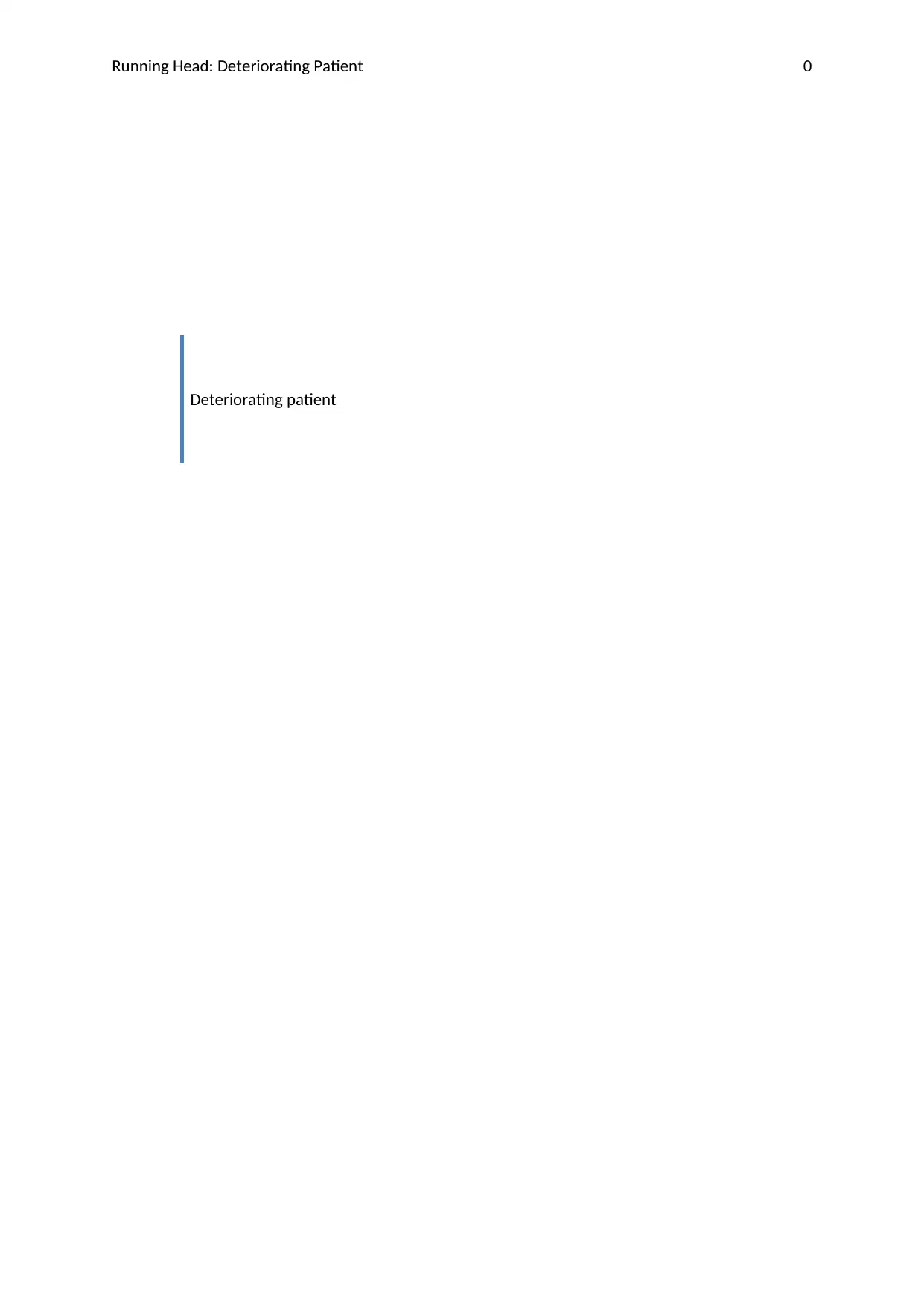
Running Head: Deteriorating Patient 0
Deteriorating patient
Deteriorating patient
Paraphrase This Document
Need a fresh take? Get an instant paraphrase of this document with our AI Paraphraser
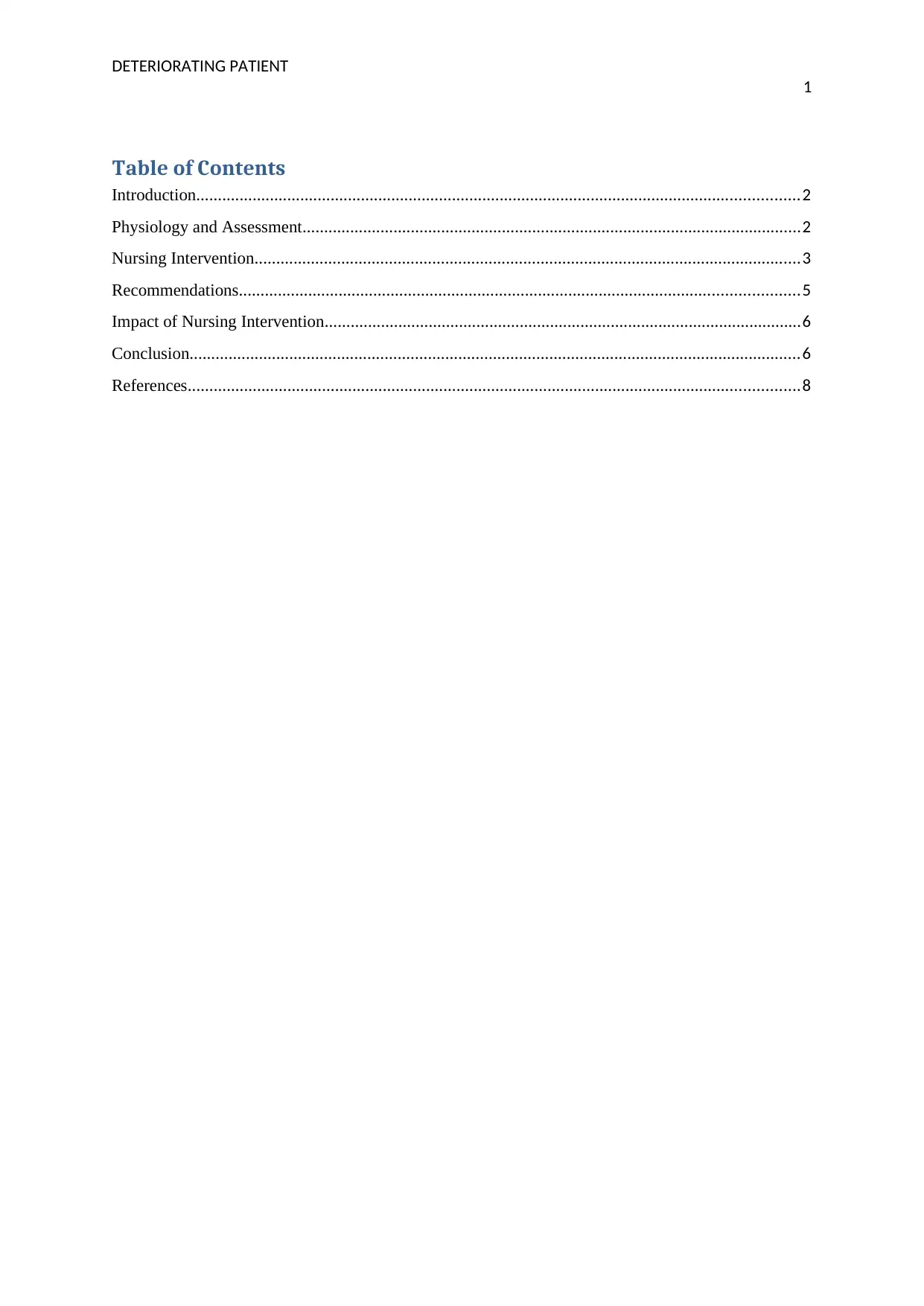
DETERIORATING PATIENT
1
Table of Contents
Introduction...........................................................................................................................................2
Physiology and Assessment...................................................................................................................2
Nursing Intervention..............................................................................................................................3
Recommendations.................................................................................................................................5
Impact of Nursing Intervention..............................................................................................................6
Conclusion.............................................................................................................................................6
References.............................................................................................................................................8
1
Table of Contents
Introduction...........................................................................................................................................2
Physiology and Assessment...................................................................................................................2
Nursing Intervention..............................................................................................................................3
Recommendations.................................................................................................................................5
Impact of Nursing Intervention..............................................................................................................6
Conclusion.............................................................................................................................................6
References.............................................................................................................................................8
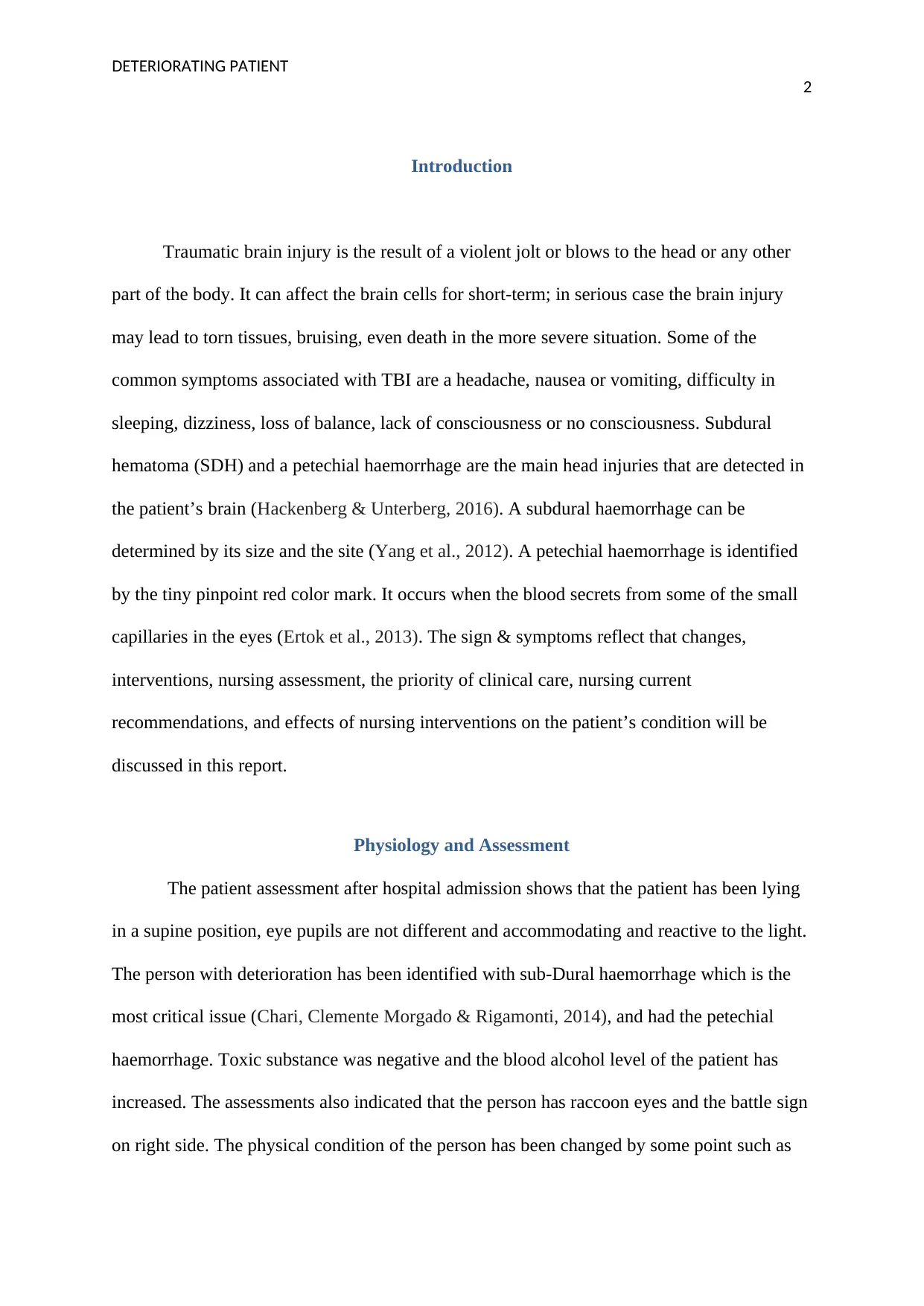
DETERIORATING PATIENT
2
Introduction
Traumatic brain injury is the result of a violent jolt or blows to the head or any other
part of the body. It can affect the brain cells for short-term; in serious case the brain injury
may lead to torn tissues, bruising, even death in the more severe situation. Some of the
common symptoms associated with TBI are a headache, nausea or vomiting, difficulty in
sleeping, dizziness, loss of balance, lack of consciousness or no consciousness. Subdural
hematoma (SDH) and a petechial haemorrhage are the main head injuries that are detected in
the patient’s brain (Hackenberg & Unterberg, 2016). A subdural haemorrhage can be
determined by its size and the site (Yang et al., 2012). A petechial haemorrhage is identified
by the tiny pinpoint red color mark. It occurs when the blood secrets from some of the small
capillaries in the eyes (Ertok et al., 2013). The sign & symptoms reflect that changes,
interventions, nursing assessment, the priority of clinical care, nursing current
recommendations, and effects of nursing interventions on the patient’s condition will be
discussed in this report.
Physiology and Assessment
The patient assessment after hospital admission shows that the patient has been lying
in a supine position, eye pupils are not different and accommodating and reactive to the light.
The person with deterioration has been identified with sub-Dural haemorrhage which is the
most critical issue (Chari, Clemente Morgado & Rigamonti, 2014), and had the petechial
haemorrhage. Toxic substance was negative and the blood alcohol level of the patient has
increased. The assessments also indicated that the person has raccoon eyes and the battle sign
on right side. The physical condition of the person has been changed by some point such as
2
Introduction
Traumatic brain injury is the result of a violent jolt or blows to the head or any other
part of the body. It can affect the brain cells for short-term; in serious case the brain injury
may lead to torn tissues, bruising, even death in the more severe situation. Some of the
common symptoms associated with TBI are a headache, nausea or vomiting, difficulty in
sleeping, dizziness, loss of balance, lack of consciousness or no consciousness. Subdural
hematoma (SDH) and a petechial haemorrhage are the main head injuries that are detected in
the patient’s brain (Hackenberg & Unterberg, 2016). A subdural haemorrhage can be
determined by its size and the site (Yang et al., 2012). A petechial haemorrhage is identified
by the tiny pinpoint red color mark. It occurs when the blood secrets from some of the small
capillaries in the eyes (Ertok et al., 2013). The sign & symptoms reflect that changes,
interventions, nursing assessment, the priority of clinical care, nursing current
recommendations, and effects of nursing interventions on the patient’s condition will be
discussed in this report.
Physiology and Assessment
The patient assessment after hospital admission shows that the patient has been lying
in a supine position, eye pupils are not different and accommodating and reactive to the light.
The person with deterioration has been identified with sub-Dural haemorrhage which is the
most critical issue (Chari, Clemente Morgado & Rigamonti, 2014), and had the petechial
haemorrhage. Toxic substance was negative and the blood alcohol level of the patient has
increased. The assessments also indicated that the person has raccoon eyes and the battle sign
on right side. The physical condition of the person has been changed by some point such as
⊘ This is a preview!⊘
Do you want full access?
Subscribe today to unlock all pages.

Trusted by 1+ million students worldwide
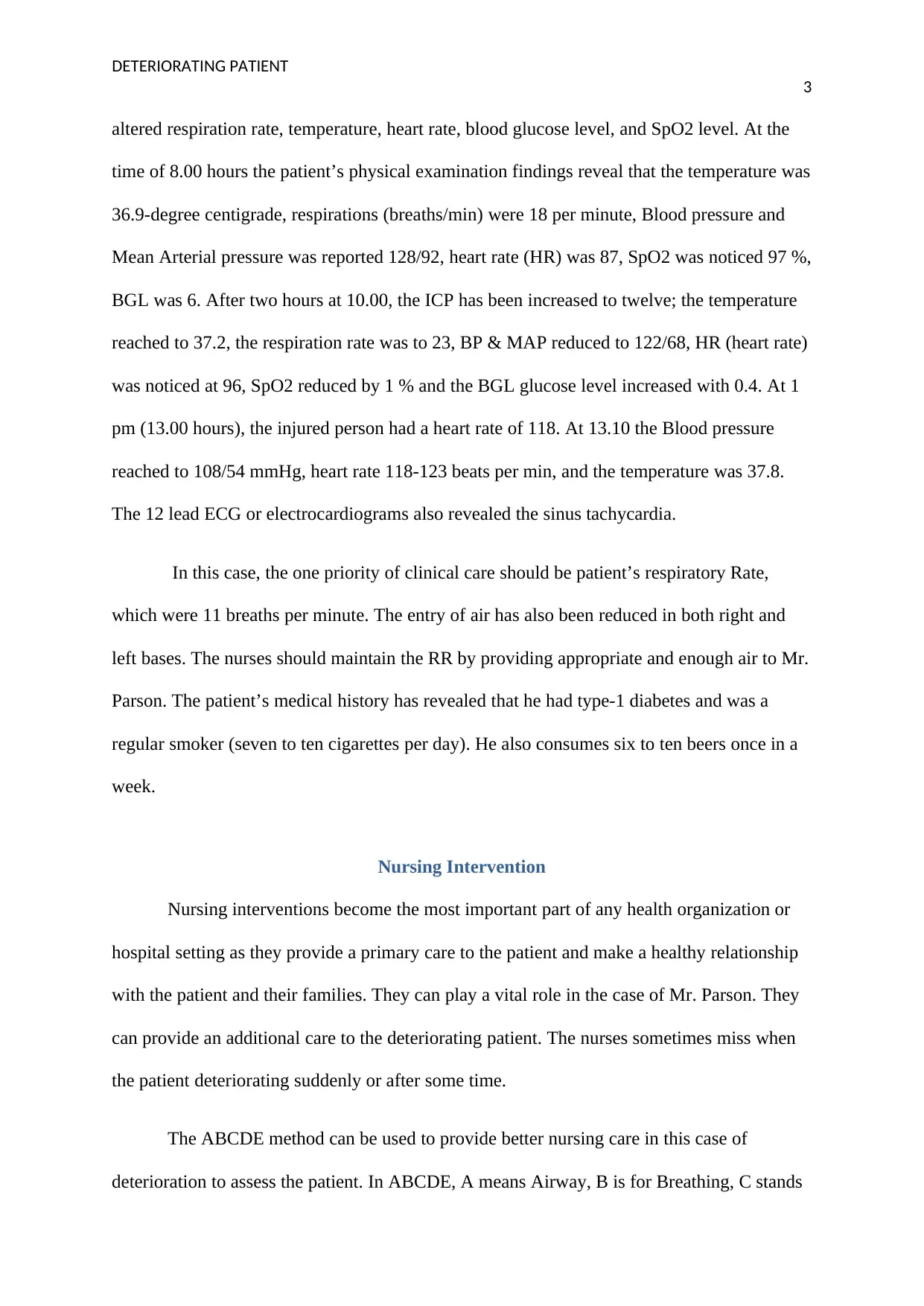
DETERIORATING PATIENT
3
altered respiration rate, temperature, heart rate, blood glucose level, and SpO2 level. At the
time of 8.00 hours the patient’s physical examination findings reveal that the temperature was
36.9-degree centigrade, respirations (breaths/min) were 18 per minute, Blood pressure and
Mean Arterial pressure was reported 128/92, heart rate (HR) was 87, SpO2 was noticed 97 %,
BGL was 6. After two hours at 10.00, the ICP has been increased to twelve; the temperature
reached to 37.2, the respiration rate was to 23, BP & MAP reduced to 122/68, HR (heart rate)
was noticed at 96, SpO2 reduced by 1 % and the BGL glucose level increased with 0.4. At 1
pm (13.00 hours), the injured person had a heart rate of 118. At 13.10 the Blood pressure
reached to 108/54 mmHg, heart rate 118-123 beats per min, and the temperature was 37.8.
The 12 lead ECG or electrocardiograms also revealed the sinus tachycardia.
In this case, the one priority of clinical care should be patient’s respiratory Rate,
which were 11 breaths per minute. The entry of air has also been reduced in both right and
left bases. The nurses should maintain the RR by providing appropriate and enough air to Mr.
Parson. The patient’s medical history has revealed that he had type-1 diabetes and was a
regular smoker (seven to ten cigarettes per day). He also consumes six to ten beers once in a
week.
Nursing Intervention
Nursing interventions become the most important part of any health organization or
hospital setting as they provide a primary care to the patient and make a healthy relationship
with the patient and their families. They can play a vital role in the case of Mr. Parson. They
can provide an additional care to the deteriorating patient. The nurses sometimes miss when
the patient deteriorating suddenly or after some time.
The ABCDE method can be used to provide better nursing care in this case of
deterioration to assess the patient. In ABCDE, A means Airway, B is for Breathing, C stands
3
altered respiration rate, temperature, heart rate, blood glucose level, and SpO2 level. At the
time of 8.00 hours the patient’s physical examination findings reveal that the temperature was
36.9-degree centigrade, respirations (breaths/min) were 18 per minute, Blood pressure and
Mean Arterial pressure was reported 128/92, heart rate (HR) was 87, SpO2 was noticed 97 %,
BGL was 6. After two hours at 10.00, the ICP has been increased to twelve; the temperature
reached to 37.2, the respiration rate was to 23, BP & MAP reduced to 122/68, HR (heart rate)
was noticed at 96, SpO2 reduced by 1 % and the BGL glucose level increased with 0.4. At 1
pm (13.00 hours), the injured person had a heart rate of 118. At 13.10 the Blood pressure
reached to 108/54 mmHg, heart rate 118-123 beats per min, and the temperature was 37.8.
The 12 lead ECG or electrocardiograms also revealed the sinus tachycardia.
In this case, the one priority of clinical care should be patient’s respiratory Rate,
which were 11 breaths per minute. The entry of air has also been reduced in both right and
left bases. The nurses should maintain the RR by providing appropriate and enough air to Mr.
Parson. The patient’s medical history has revealed that he had type-1 diabetes and was a
regular smoker (seven to ten cigarettes per day). He also consumes six to ten beers once in a
week.
Nursing Intervention
Nursing interventions become the most important part of any health organization or
hospital setting as they provide a primary care to the patient and make a healthy relationship
with the patient and their families. They can play a vital role in the case of Mr. Parson. They
can provide an additional care to the deteriorating patient. The nurses sometimes miss when
the patient deteriorating suddenly or after some time.
The ABCDE method can be used to provide better nursing care in this case of
deterioration to assess the patient. In ABCDE, A means Airway, B is for Breathing, C stands
Paraphrase This Document
Need a fresh take? Get an instant paraphrase of this document with our AI Paraphraser
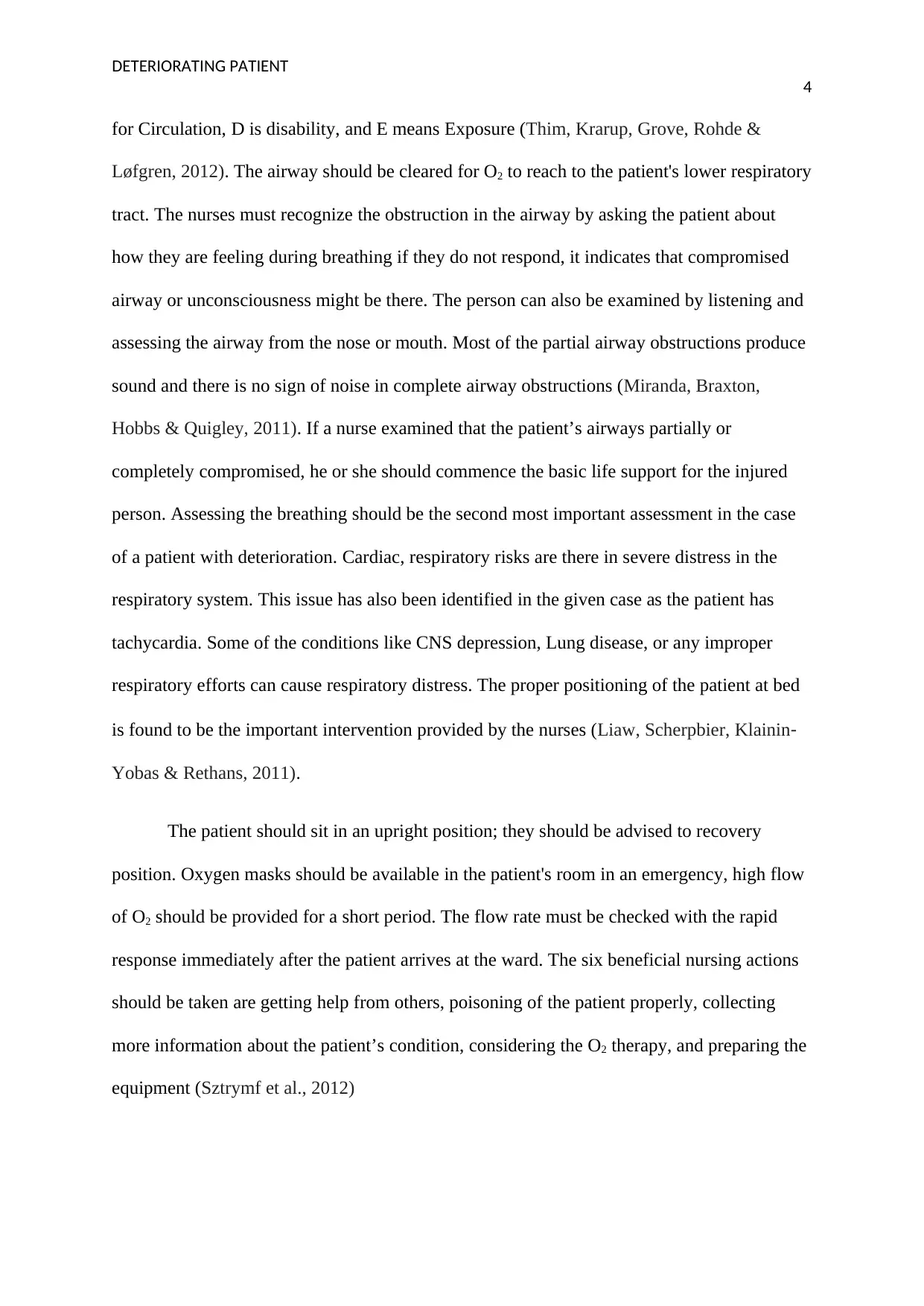
DETERIORATING PATIENT
4
for Circulation, D is disability, and E means Exposure (Thim, Krarup, Grove, Rohde &
Løfgren, 2012). The airway should be cleared for O2 to reach to the patient's lower respiratory
tract. The nurses must recognize the obstruction in the airway by asking the patient about
how they are feeling during breathing if they do not respond, it indicates that compromised
airway or unconsciousness might be there. The person can also be examined by listening and
assessing the airway from the nose or mouth. Most of the partial airway obstructions produce
sound and there is no sign of noise in complete airway obstructions (Miranda, Braxton,
Hobbs & Quigley, 2011). If a nurse examined that the patient’s airways partially or
completely compromised, he or she should commence the basic life support for the injured
person. Assessing the breathing should be the second most important assessment in the case
of a patient with deterioration. Cardiac, respiratory risks are there in severe distress in the
respiratory system. This issue has also been identified in the given case as the patient has
tachycardia. Some of the conditions like CNS depression, Lung disease, or any improper
respiratory efforts can cause respiratory distress. The proper positioning of the patient at bed
is found to be the important intervention provided by the nurses (Liaw, Scherpbier, Klainin‐
Yobas & Rethans, 2011).
The patient should sit in an upright position; they should be advised to recovery
position. Oxygen masks should be available in the patient's room in an emergency, high flow
of O2 should be provided for a short period. The flow rate must be checked with the rapid
response immediately after the patient arrives at the ward. The six beneficial nursing actions
should be taken are getting help from others, poisoning of the patient properly, collecting
more information about the patient’s condition, considering the O2 therapy, and preparing the
equipment (Sztrymf et al., 2012)
4
for Circulation, D is disability, and E means Exposure (Thim, Krarup, Grove, Rohde &
Løfgren, 2012). The airway should be cleared for O2 to reach to the patient's lower respiratory
tract. The nurses must recognize the obstruction in the airway by asking the patient about
how they are feeling during breathing if they do not respond, it indicates that compromised
airway or unconsciousness might be there. The person can also be examined by listening and
assessing the airway from the nose or mouth. Most of the partial airway obstructions produce
sound and there is no sign of noise in complete airway obstructions (Miranda, Braxton,
Hobbs & Quigley, 2011). If a nurse examined that the patient’s airways partially or
completely compromised, he or she should commence the basic life support for the injured
person. Assessing the breathing should be the second most important assessment in the case
of a patient with deterioration. Cardiac, respiratory risks are there in severe distress in the
respiratory system. This issue has also been identified in the given case as the patient has
tachycardia. Some of the conditions like CNS depression, Lung disease, or any improper
respiratory efforts can cause respiratory distress. The proper positioning of the patient at bed
is found to be the important intervention provided by the nurses (Liaw, Scherpbier, Klainin‐
Yobas & Rethans, 2011).
The patient should sit in an upright position; they should be advised to recovery
position. Oxygen masks should be available in the patient's room in an emergency, high flow
of O2 should be provided for a short period. The flow rate must be checked with the rapid
response immediately after the patient arrives at the ward. The six beneficial nursing actions
should be taken are getting help from others, poisoning of the patient properly, collecting
more information about the patient’s condition, considering the O2 therapy, and preparing the
equipment (Sztrymf et al., 2012)
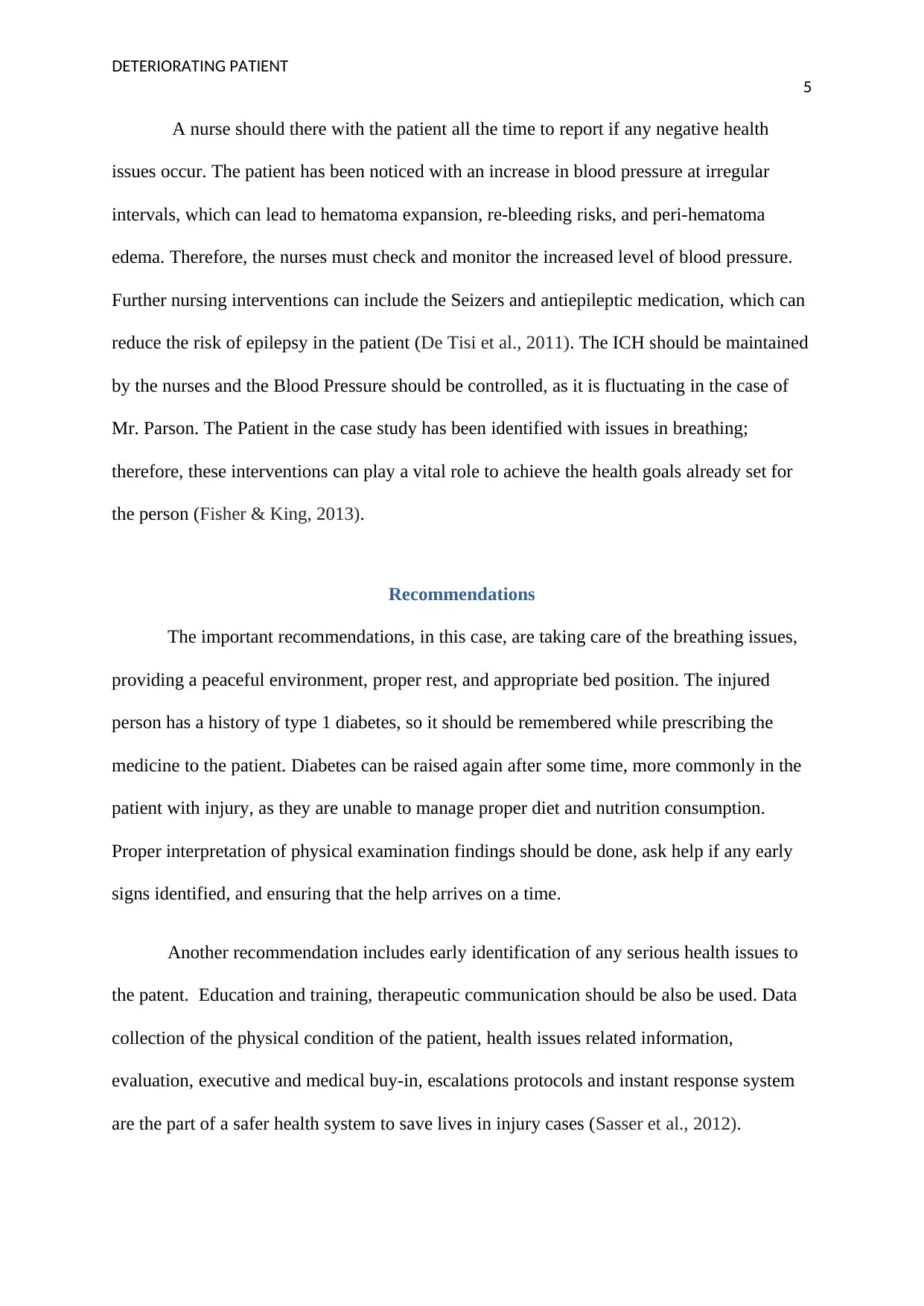
DETERIORATING PATIENT
5
A nurse should there with the patient all the time to report if any negative health
issues occur. The patient has been noticed with an increase in blood pressure at irregular
intervals, which can lead to hematoma expansion, re-bleeding risks, and peri-hematoma
edema. Therefore, the nurses must check and monitor the increased level of blood pressure.
Further nursing interventions can include the Seizers and antiepileptic medication, which can
reduce the risk of epilepsy in the patient (De Tisi et al., 2011). The ICH should be maintained
by the nurses and the Blood Pressure should be controlled, as it is fluctuating in the case of
Mr. Parson. The Patient in the case study has been identified with issues in breathing;
therefore, these interventions can play a vital role to achieve the health goals already set for
the person (Fisher & King, 2013).
Recommendations
The important recommendations, in this case, are taking care of the breathing issues,
providing a peaceful environment, proper rest, and appropriate bed position. The injured
person has a history of type 1 diabetes, so it should be remembered while prescribing the
medicine to the patient. Diabetes can be raised again after some time, more commonly in the
patient with injury, as they are unable to manage proper diet and nutrition consumption.
Proper interpretation of physical examination findings should be done, ask help if any early
signs identified, and ensuring that the help arrives on a time.
Another recommendation includes early identification of any serious health issues to
the patent. Education and training, therapeutic communication should be also be used. Data
collection of the physical condition of the patient, health issues related information,
evaluation, executive and medical buy-in, escalations protocols and instant response system
are the part of a safer health system to save lives in injury cases (Sasser et al., 2012).
5
A nurse should there with the patient all the time to report if any negative health
issues occur. The patient has been noticed with an increase in blood pressure at irregular
intervals, which can lead to hematoma expansion, re-bleeding risks, and peri-hematoma
edema. Therefore, the nurses must check and monitor the increased level of blood pressure.
Further nursing interventions can include the Seizers and antiepileptic medication, which can
reduce the risk of epilepsy in the patient (De Tisi et al., 2011). The ICH should be maintained
by the nurses and the Blood Pressure should be controlled, as it is fluctuating in the case of
Mr. Parson. The Patient in the case study has been identified with issues in breathing;
therefore, these interventions can play a vital role to achieve the health goals already set for
the person (Fisher & King, 2013).
Recommendations
The important recommendations, in this case, are taking care of the breathing issues,
providing a peaceful environment, proper rest, and appropriate bed position. The injured
person has a history of type 1 diabetes, so it should be remembered while prescribing the
medicine to the patient. Diabetes can be raised again after some time, more commonly in the
patient with injury, as they are unable to manage proper diet and nutrition consumption.
Proper interpretation of physical examination findings should be done, ask help if any early
signs identified, and ensuring that the help arrives on a time.
Another recommendation includes early identification of any serious health issues to
the patent. Education and training, therapeutic communication should be also be used. Data
collection of the physical condition of the patient, health issues related information,
evaluation, executive and medical buy-in, escalations protocols and instant response system
are the part of a safer health system to save lives in injury cases (Sasser et al., 2012).
⊘ This is a preview!⊘
Do you want full access?
Subscribe today to unlock all pages.

Trusted by 1+ million students worldwide
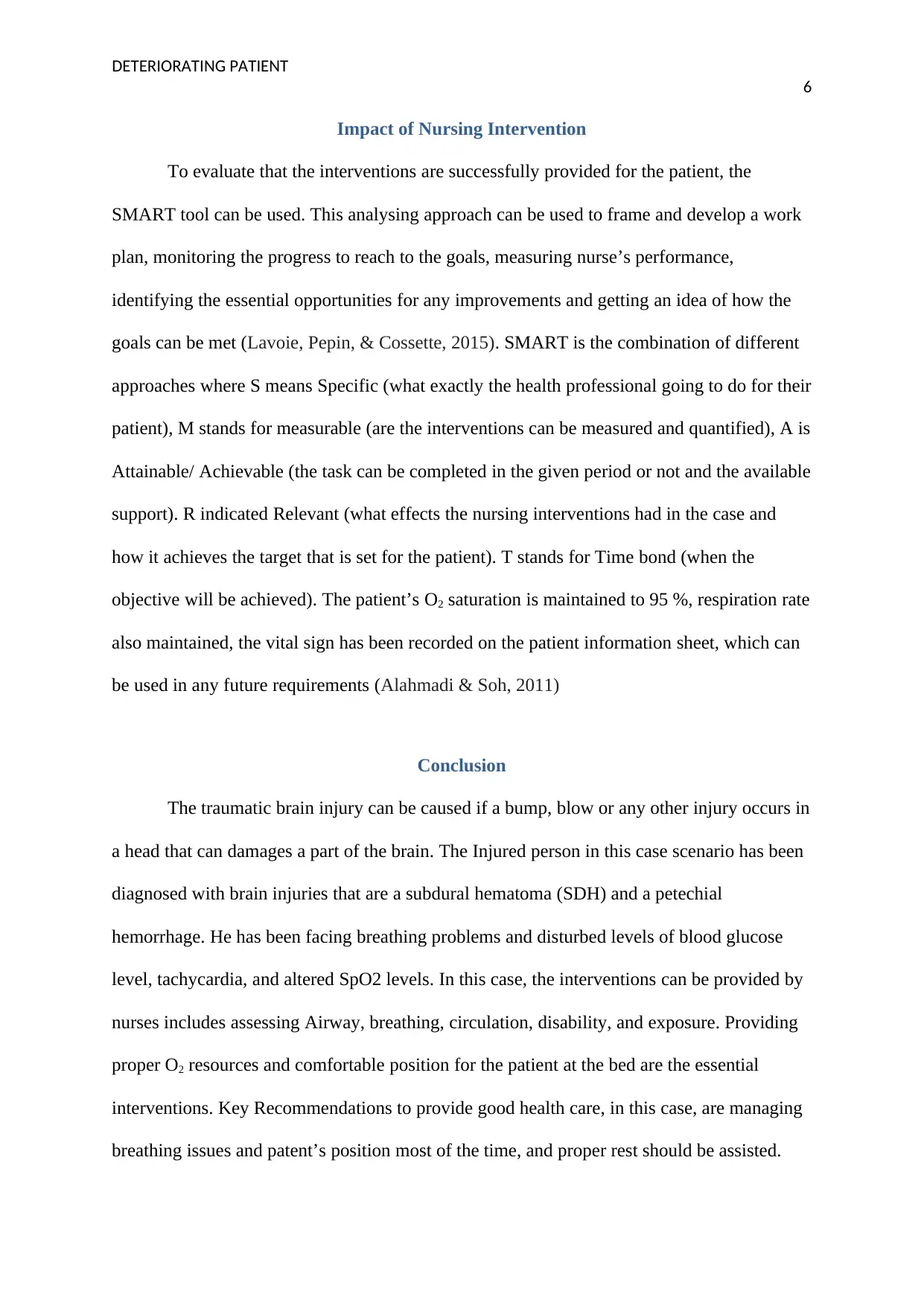
DETERIORATING PATIENT
6
Impact of Nursing Intervention
To evaluate that the interventions are successfully provided for the patient, the
SMART tool can be used. This analysing approach can be used to frame and develop a work
plan, monitoring the progress to reach to the goals, measuring nurse’s performance,
identifying the essential opportunities for any improvements and getting an idea of how the
goals can be met (Lavoie, Pepin, & Cossette, 2015). SMART is the combination of different
approaches where S means Specific (what exactly the health professional going to do for their
patient), M stands for measurable (are the interventions can be measured and quantified), A is
Attainable/ Achievable (the task can be completed in the given period or not and the available
support). R indicated Relevant (what effects the nursing interventions had in the case and
how it achieves the target that is set for the patient). T stands for Time bond (when the
objective will be achieved). The patient’s O2 saturation is maintained to 95 %, respiration rate
also maintained, the vital sign has been recorded on the patient information sheet, which can
be used in any future requirements (Alahmadi & Soh, 2011)
Conclusion
The traumatic brain injury can be caused if a bump, blow or any other injury occurs in
a head that can damages a part of the brain. The Injured person in this case scenario has been
diagnosed with brain injuries that are a subdural hematoma (SDH) and a petechial
hemorrhage. He has been facing breathing problems and disturbed levels of blood glucose
level, tachycardia, and altered SpO2 levels. In this case, the interventions can be provided by
nurses includes assessing Airway, breathing, circulation, disability, and exposure. Providing
proper O2 resources and comfortable position for the patient at the bed are the essential
interventions. Key Recommendations to provide good health care, in this case, are managing
breathing issues and patent’s position most of the time, and proper rest should be assisted.
6
Impact of Nursing Intervention
To evaluate that the interventions are successfully provided for the patient, the
SMART tool can be used. This analysing approach can be used to frame and develop a work
plan, monitoring the progress to reach to the goals, measuring nurse’s performance,
identifying the essential opportunities for any improvements and getting an idea of how the
goals can be met (Lavoie, Pepin, & Cossette, 2015). SMART is the combination of different
approaches where S means Specific (what exactly the health professional going to do for their
patient), M stands for measurable (are the interventions can be measured and quantified), A is
Attainable/ Achievable (the task can be completed in the given period or not and the available
support). R indicated Relevant (what effects the nursing interventions had in the case and
how it achieves the target that is set for the patient). T stands for Time bond (when the
objective will be achieved). The patient’s O2 saturation is maintained to 95 %, respiration rate
also maintained, the vital sign has been recorded on the patient information sheet, which can
be used in any future requirements (Alahmadi & Soh, 2011)
Conclusion
The traumatic brain injury can be caused if a bump, blow or any other injury occurs in
a head that can damages a part of the brain. The Injured person in this case scenario has been
diagnosed with brain injuries that are a subdural hematoma (SDH) and a petechial
hemorrhage. He has been facing breathing problems and disturbed levels of blood glucose
level, tachycardia, and altered SpO2 levels. In this case, the interventions can be provided by
nurses includes assessing Airway, breathing, circulation, disability, and exposure. Providing
proper O2 resources and comfortable position for the patient at the bed are the essential
interventions. Key Recommendations to provide good health care, in this case, are managing
breathing issues and patent’s position most of the time, and proper rest should be assisted.
Paraphrase This Document
Need a fresh take? Get an instant paraphrase of this document with our AI Paraphraser
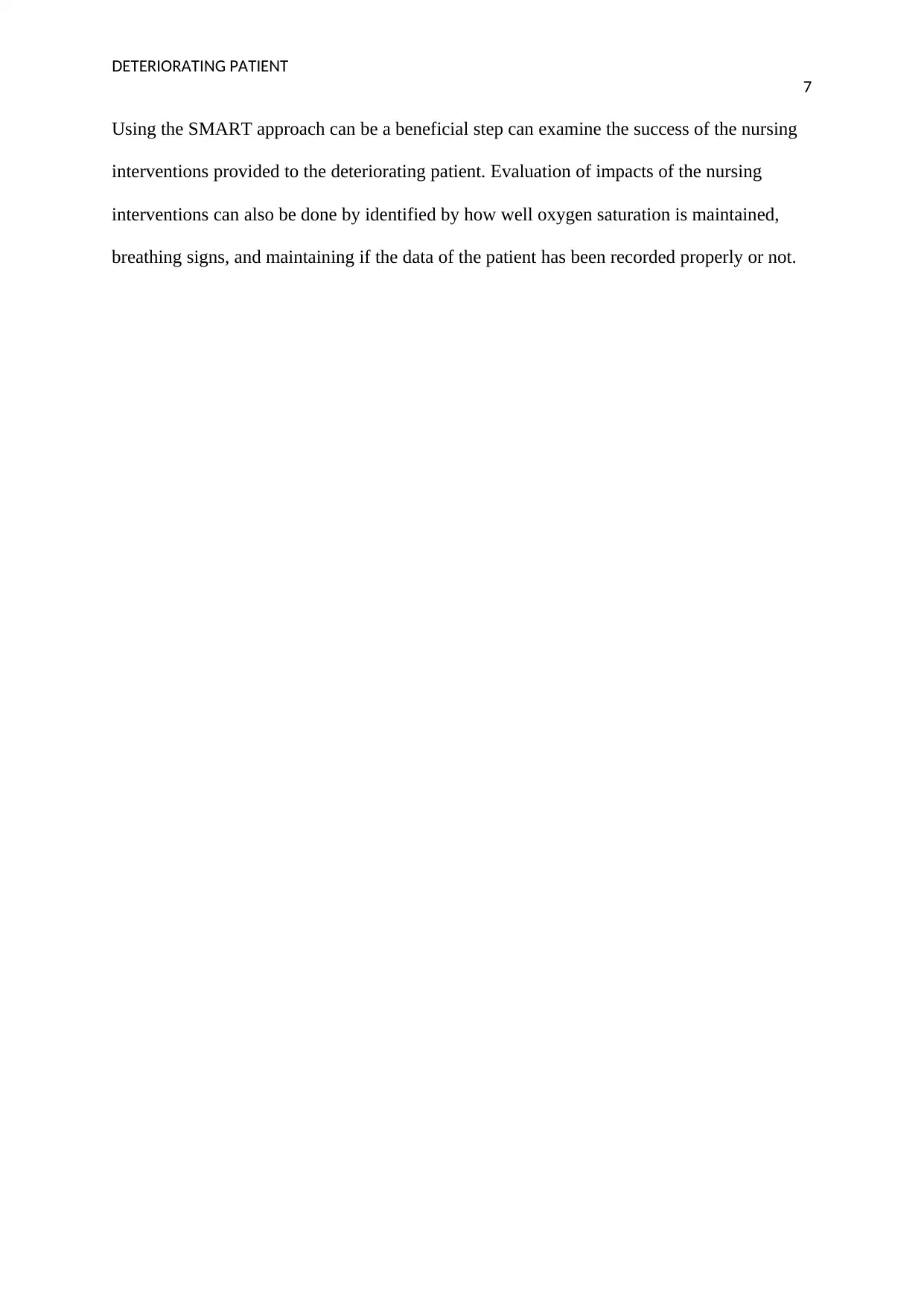
DETERIORATING PATIENT
7
Using the SMART approach can be a beneficial step can examine the success of the nursing
interventions provided to the deteriorating patient. Evaluation of impacts of the nursing
interventions can also be done by identified by how well oxygen saturation is maintained,
breathing signs, and maintaining if the data of the patient has been recorded properly or not.
7
Using the SMART approach can be a beneficial step can examine the success of the nursing
interventions provided to the deteriorating patient. Evaluation of impacts of the nursing
interventions can also be done by identified by how well oxygen saturation is maintained,
breathing signs, and maintaining if the data of the patient has been recorded properly or not.
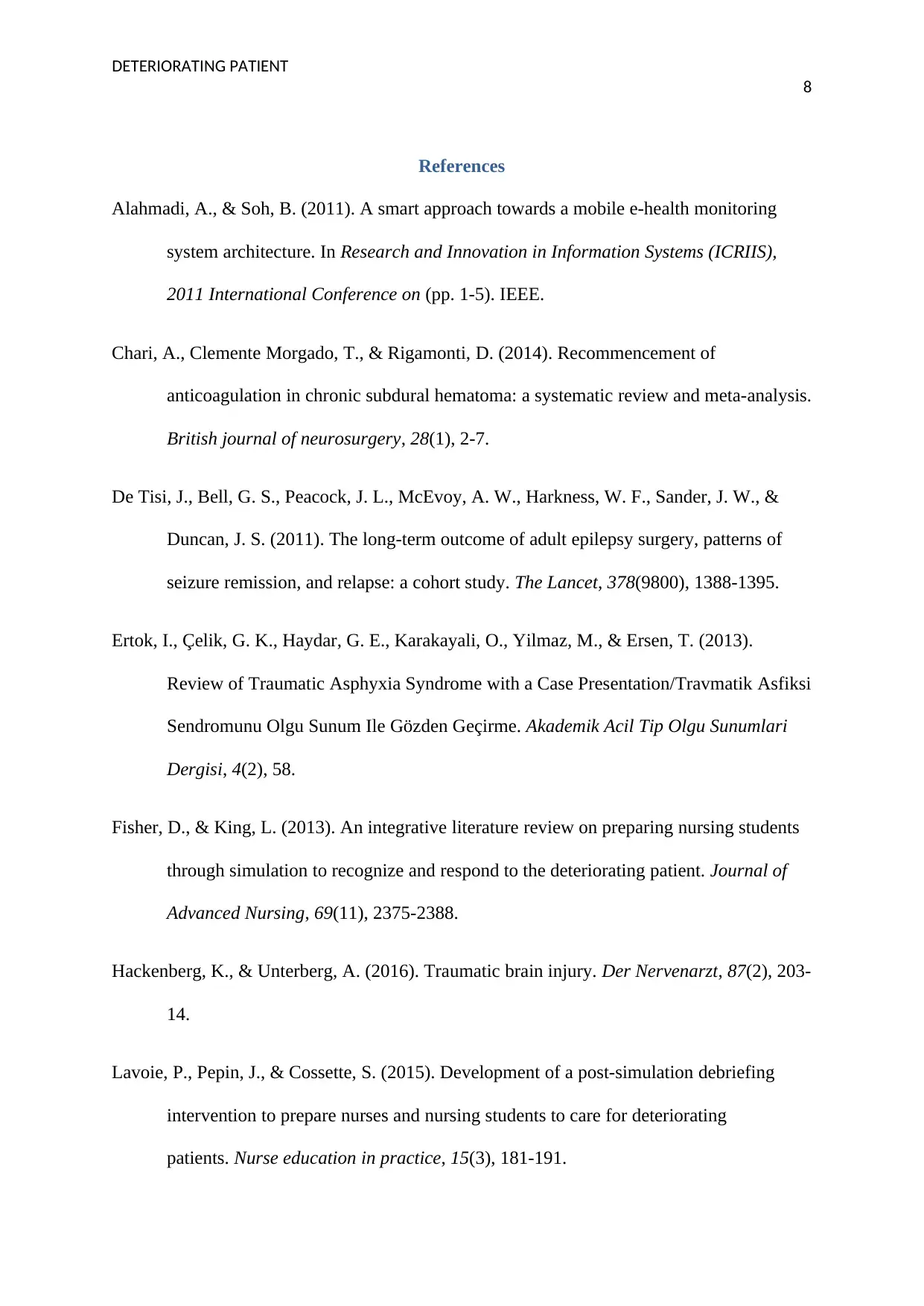
DETERIORATING PATIENT
8
References
Alahmadi, A., & Soh, B. (2011). A smart approach towards a mobile e-health monitoring
system architecture. In Research and Innovation in Information Systems (ICRIIS),
2011 International Conference on (pp. 1-5). IEEE.
Chari, A., Clemente Morgado, T., & Rigamonti, D. (2014). Recommencement of
anticoagulation in chronic subdural hematoma: a systematic review and meta-analysis.
British journal of neurosurgery, 28(1), 2-7.
De Tisi, J., Bell, G. S., Peacock, J. L., McEvoy, A. W., Harkness, W. F., Sander, J. W., &
Duncan, J. S. (2011). The long-term outcome of adult epilepsy surgery, patterns of
seizure remission, and relapse: a cohort study. The Lancet, 378(9800), 1388-1395.
Ertok, I., Çelik, G. K., Haydar, G. E., Karakayali, O., Yilmaz, M., & Ersen, T. (2013).
Review of Traumatic Asphyxia Syndrome with a Case Presentation/Travmatik Asfiksi
Sendromunu Olgu Sunum Ile Gözden Geçirme. Akademik Acil Tip Olgu Sunumlari
Dergisi, 4(2), 58.
Fisher, D., & King, L. (2013). An integrative literature review on preparing nursing students
through simulation to recognize and respond to the deteriorating patient. Journal of
Advanced Nursing, 69(11), 2375-2388.
Hackenberg, K., & Unterberg, A. (2016). Traumatic brain injury. Der Nervenarzt, 87(2), 203-
14.
Lavoie, P., Pepin, J., & Cossette, S. (2015). Development of a post-simulation debriefing
intervention to prepare nurses and nursing students to care for deteriorating
patients. Nurse education in practice, 15(3), 181-191.
8
References
Alahmadi, A., & Soh, B. (2011). A smart approach towards a mobile e-health monitoring
system architecture. In Research and Innovation in Information Systems (ICRIIS),
2011 International Conference on (pp. 1-5). IEEE.
Chari, A., Clemente Morgado, T., & Rigamonti, D. (2014). Recommencement of
anticoagulation in chronic subdural hematoma: a systematic review and meta-analysis.
British journal of neurosurgery, 28(1), 2-7.
De Tisi, J., Bell, G. S., Peacock, J. L., McEvoy, A. W., Harkness, W. F., Sander, J. W., &
Duncan, J. S. (2011). The long-term outcome of adult epilepsy surgery, patterns of
seizure remission, and relapse: a cohort study. The Lancet, 378(9800), 1388-1395.
Ertok, I., Çelik, G. K., Haydar, G. E., Karakayali, O., Yilmaz, M., & Ersen, T. (2013).
Review of Traumatic Asphyxia Syndrome with a Case Presentation/Travmatik Asfiksi
Sendromunu Olgu Sunum Ile Gözden Geçirme. Akademik Acil Tip Olgu Sunumlari
Dergisi, 4(2), 58.
Fisher, D., & King, L. (2013). An integrative literature review on preparing nursing students
through simulation to recognize and respond to the deteriorating patient. Journal of
Advanced Nursing, 69(11), 2375-2388.
Hackenberg, K., & Unterberg, A. (2016). Traumatic brain injury. Der Nervenarzt, 87(2), 203-
14.
Lavoie, P., Pepin, J., & Cossette, S. (2015). Development of a post-simulation debriefing
intervention to prepare nurses and nursing students to care for deteriorating
patients. Nurse education in practice, 15(3), 181-191.
⊘ This is a preview!⊘
Do you want full access?
Subscribe today to unlock all pages.

Trusted by 1+ million students worldwide
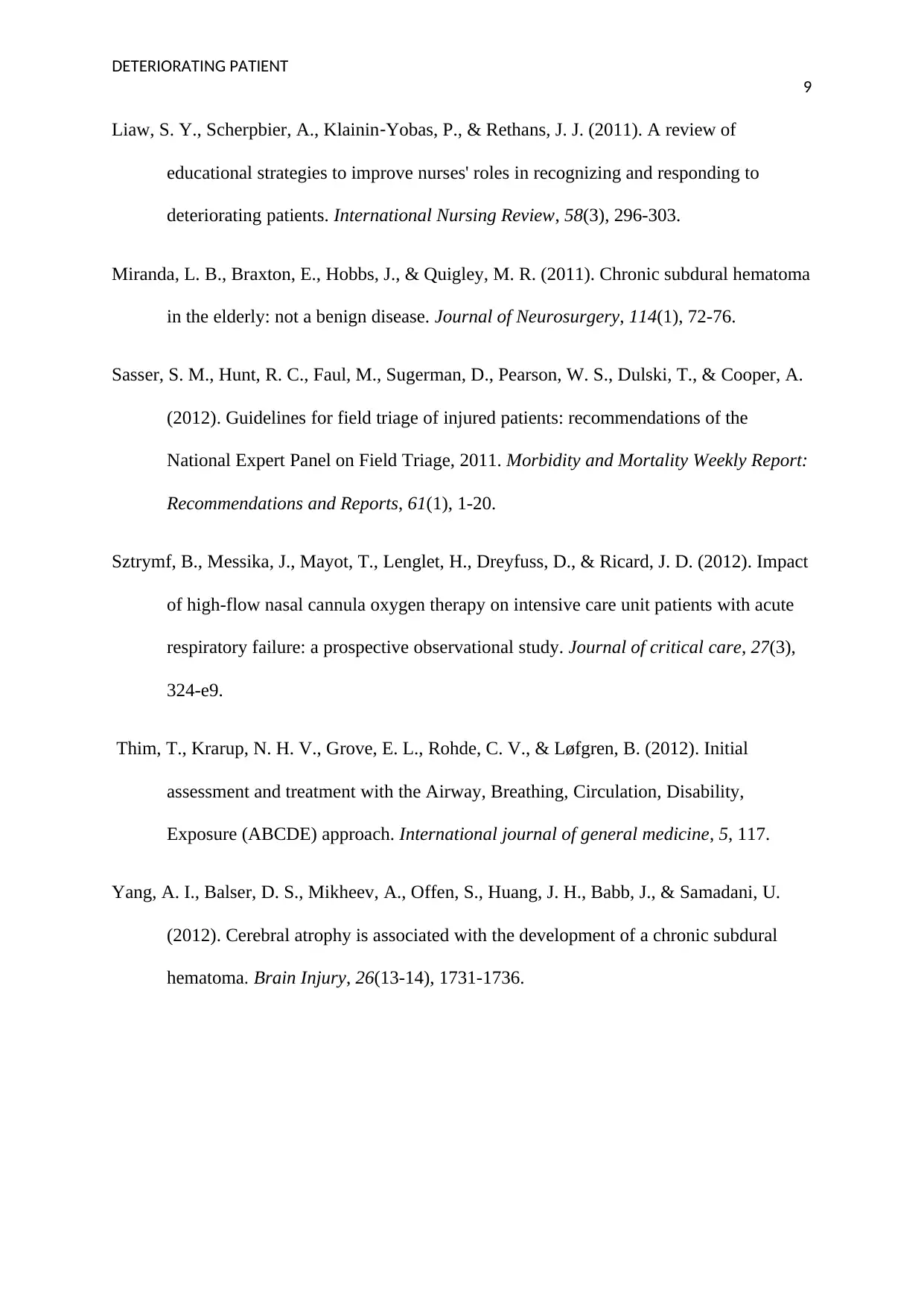
DETERIORATING PATIENT
9
Liaw, S. Y., Scherpbier, A., Klainin‐Yobas, P., & Rethans, J. J. (2011). A review of
educational strategies to improve nurses' roles in recognizing and responding to
deteriorating patients. International Nursing Review, 58(3), 296-303.
Miranda, L. B., Braxton, E., Hobbs, J., & Quigley, M. R. (2011). Chronic subdural hematoma
in the elderly: not a benign disease. Journal of Neurosurgery, 114(1), 72-76.
Sasser, S. M., Hunt, R. C., Faul, M., Sugerman, D., Pearson, W. S., Dulski, T., & Cooper, A.
(2012). Guidelines for field triage of injured patients: recommendations of the
National Expert Panel on Field Triage, 2011. Morbidity and Mortality Weekly Report:
Recommendations and Reports, 61(1), 1-20.
Sztrymf, B., Messika, J., Mayot, T., Lenglet, H., Dreyfuss, D., & Ricard, J. D. (2012). Impact
of high-flow nasal cannula oxygen therapy on intensive care unit patients with acute
respiratory failure: a prospective observational study. Journal of critical care, 27(3),
324-e9.
Thim, T., Krarup, N. H. V., Grove, E. L., Rohde, C. V., & Løfgren, B. (2012). Initial
assessment and treatment with the Airway, Breathing, Circulation, Disability,
Exposure (ABCDE) approach. International journal of general medicine, 5, 117.
Yang, A. I., Balser, D. S., Mikheev, A., Offen, S., Huang, J. H., Babb, J., & Samadani, U.
(2012). Cerebral atrophy is associated with the development of a chronic subdural
hematoma. Brain Injury, 26(13-14), 1731-1736.
9
Liaw, S. Y., Scherpbier, A., Klainin‐Yobas, P., & Rethans, J. J. (2011). A review of
educational strategies to improve nurses' roles in recognizing and responding to
deteriorating patients. International Nursing Review, 58(3), 296-303.
Miranda, L. B., Braxton, E., Hobbs, J., & Quigley, M. R. (2011). Chronic subdural hematoma
in the elderly: not a benign disease. Journal of Neurosurgery, 114(1), 72-76.
Sasser, S. M., Hunt, R. C., Faul, M., Sugerman, D., Pearson, W. S., Dulski, T., & Cooper, A.
(2012). Guidelines for field triage of injured patients: recommendations of the
National Expert Panel on Field Triage, 2011. Morbidity and Mortality Weekly Report:
Recommendations and Reports, 61(1), 1-20.
Sztrymf, B., Messika, J., Mayot, T., Lenglet, H., Dreyfuss, D., & Ricard, J. D. (2012). Impact
of high-flow nasal cannula oxygen therapy on intensive care unit patients with acute
respiratory failure: a prospective observational study. Journal of critical care, 27(3),
324-e9.
Thim, T., Krarup, N. H. V., Grove, E. L., Rohde, C. V., & Løfgren, B. (2012). Initial
assessment and treatment with the Airway, Breathing, Circulation, Disability,
Exposure (ABCDE) approach. International journal of general medicine, 5, 117.
Yang, A. I., Balser, D. S., Mikheev, A., Offen, S., Huang, J. H., Babb, J., & Samadani, U.
(2012). Cerebral atrophy is associated with the development of a chronic subdural
hematoma. Brain Injury, 26(13-14), 1731-1736.
1 out of 10
Related Documents
Your All-in-One AI-Powered Toolkit for Academic Success.
+13062052269
info@desklib.com
Available 24*7 on WhatsApp / Email
![[object Object]](/_next/static/media/star-bottom.7253800d.svg)
Unlock your academic potential
Copyright © 2020–2025 A2Z Services. All Rights Reserved. Developed and managed by ZUCOL.




